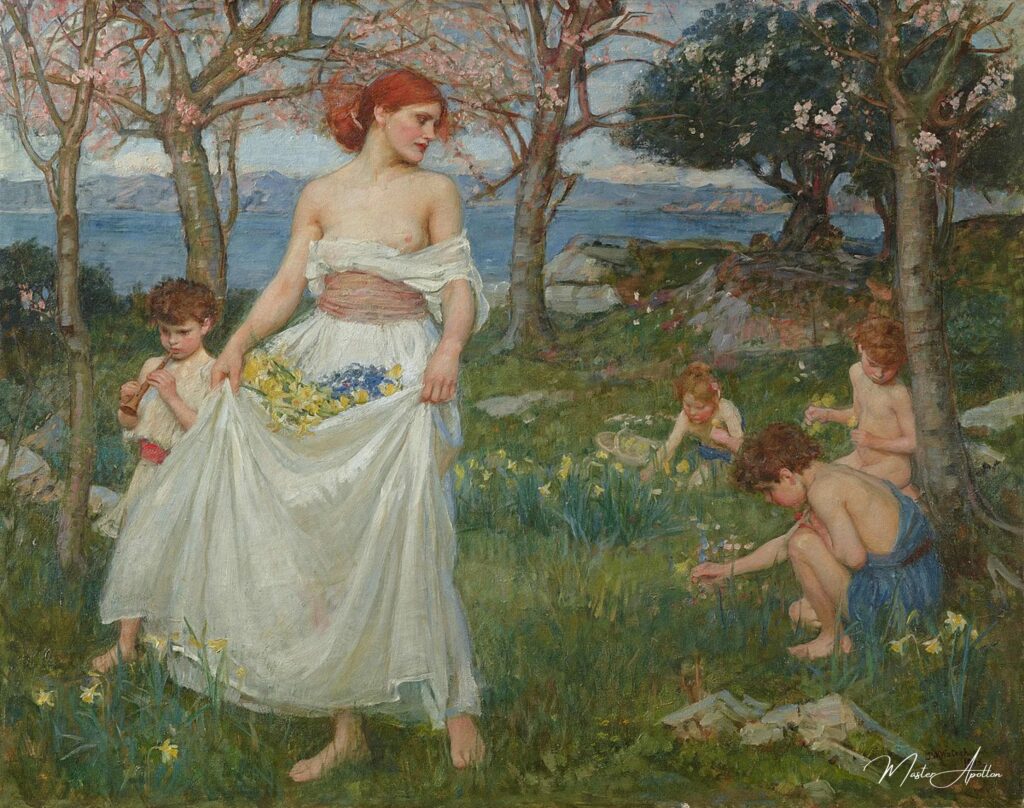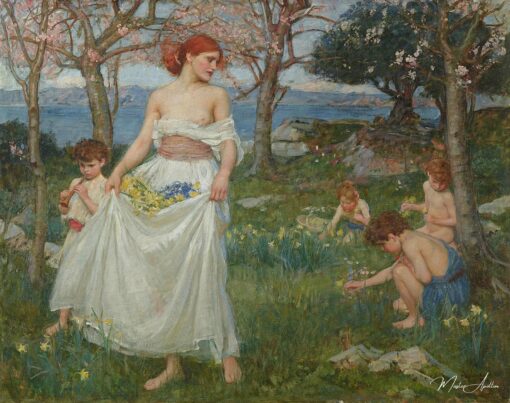Your cart is currently empty!

A Song Of Springtime – John William Waterhouse
Immerse yourself in the enchanting world of John William Waterhouse with our highest quality oil painting reproduction of “A Song of Springtime.” This exquisite piece captures the essence of renewal and beauty, inviting you to experience the delicate interplay of light and color that defines Waterhouse’s masterful technique.
As you gaze upon the vibrant hues of spring, feel the gentle caress …
A Song of Springtime – John William Waterhouse
John William Waterhouse, renowned for his lush, poetic depictions of classical mythology and literature, captures the essence of renewal and nature in his 1913 painting A Song of Springtime. Through this piece, Waterhouse invites viewers into a world where beauty, vitality, and hope spring forth from the earth. The painting is an ode to the arrival of spring, both as a season of the year and as a metaphor for the rejuvenation of the spirit.
The Essence of Spring
In A Song of Springtime, Waterhouse evokes the power and beauty of spring as it transforms the natural world. The figure of a young woman, symbolizing spring itself, emerges from the landscape, surrounded by lush greenery, blossoming flowers, and the vibrant colors of nature in full bloom. The imagery is not just a celebration of the season but also a powerful statement on the themes of growth, renewal, and the cyclical nature of life.
Waterhouse often depicted mythological and allegorical figures, and here he uses the symbolism of spring to suggest themes of fertility, transformation, and the vitality of life. The figure of spring is often associated with the life-giving forces of nature, and Waterhouse does not disappoint in portraying her as an embodiment of these very elements.
Composition and Symbolism
1. The Central Figure – A Maiden of Spring
The central figure in the painting is a young woman, draped in soft, flowing garments, with flowers in her hair and a serene, almost ethereal expression. She is the very personification of spring, her presence bringing vitality and beauty to the landscape around her. Her posture and expression suggest a quiet, gentle celebration of the season’s arrival, a reflection of the renewal and rejuvenation that spring embodies.
The flowers in her hair and the delicate blossoms around her reinforce the idea of spring as a time of fertility and new beginnings. She seems to be singing a song, a visual representation of the joy and harmony associated with the arrival of spring. Her gaze is soft but confident, as if she is serenading the earth and welcoming the season’s rebirth.
2. The Bountiful Landscape
The background of the painting is filled with a lush, vibrant landscape that embodies the richness of spring. Tall grasses, colorful flowers, and leafy trees surround the figure, reinforcing the idea of nature coming to life. The soft, sunlit atmosphere imbues the scene with warmth and promise, evoking a sense of harmony between the human figure and the earth.
The details in the landscape reflect Waterhouse’s meticulous attention to nature’s beauty. The flowers and foliage seem to be in full bloom, with every petal and leaf rendered with a sense of vitality that complements the youthful energy of the central figure. The landscape becomes more than just a setting—it is an essential part of the narrative, amplifying the themes of growth and renewal.
3. A Sense of Movement and Harmony
Waterhouse’s masterful use of color and light gives the painting a sense of fluidity and movement. The soft, flowing garments of the maiden, the rippling texture of the grasses, and the gentle sway of the flowers in the breeze create an impression of life in motion. The figure’s gesture, as if she is singing or calling to the earth, reinforces the idea that spring is not merely a passive occurrence but an active force that brings forth life and vitality.
The harmony between the figure and her environment highlights the interconnectedness of all living things. Waterhouse subtly suggests that the arrival of spring is not just an external event but one that resonates deeply within the human soul, awakening a sense of beauty, hope, and renewal.
Themes and Interpretation
1. The Rebirth of Nature
At the heart of A Song of Springtime is the theme of rebirth. Spring is traditionally a time when nature shakes off the cold, harsh grip of winter and comes alive with new growth. The young woman in the painting symbolizes this process of renewal, standing as a metaphor for the rejuvenation of both nature and the human spirit. Her gentle, inviting presence reflects the calm, life-affirming energy that spring brings with it.
Waterhouse’s depiction of spring as a goddess or muse also ties into the classical tradition of representing nature through divine figures. In this context, the maiden is not only a symbol of the season but also an embodiment of the timeless connection between humanity and the natural world.
2. The Harmony of Nature
Another significant theme in the painting is the harmonious relationship between humanity and the environment. Waterhouse often celebrated the beauty of nature, and in A Song of Springtime, he emphasizes the interconnectedness of life. The maiden is at one with the flowers, trees, and grasses that surround her, suggesting that spring’s beauty and vitality are a shared experience. Her presence in the landscape represents a symbiotic relationship where both the human and the natural world are in perfect harmony.
3. Hope and Rejuvenation
Spring is widely seen as a season of hope, and A Song of Springtime captures this sense of optimism and rejuvenation. The painting’s soft colors, the gentle expression of the figure, and the vibrant surroundings all evoke a sense of warmth, tranquility, and promise. The woman’s song, though visually silent, fills the air with the potential of new beginnings, inviting the viewer to embrace the possibilities that lie ahead.
Waterhouse’s portrayal of spring as a living, breathing force offers a sense of renewal not only for nature but for the human spirit as well. In this sense, the painting becomes a visual celebration of life’s cyclical nature and the perpetual hope that each new season brings.
Waterhouse’s Artistic Technique
Waterhouse’s attention to detail in this piece is exemplary, as seen in the vibrant depiction of the flowers, the soft folds of the maiden’s gown, and the lushness of the landscape. His use of light and shadow creates a sense of depth and dimension, while the vibrant colors convey the fullness of spring. The softness of the palette, combined with the fluidity of the composition, enhances the feeling of lightness and grace.
The texture of the painting, from the petals of the flowers to the texture of the maiden’s skin, adds an element of realism while maintaining an ethereal quality. Waterhouse’s ability to blend fantasy and reality is evident in the way he captures both the tangible and intangible qualities of spring. The painting is not just a depiction of a season—it is a poetic interpretation of the emotions and sensations that spring inspires.
Conclusion
The Song of Springtime by John William Waterhouse is a celebration of nature’s eternal cycle of renewal and rebirth. Through his masterful use of color, light, and symbolism, Waterhouse brings to life the vibrant energy of spring, personified by the gentle, alluring figure of the maiden. The painting not only captures the physical beauty of the season but also evokes the emotional and spiritual renewal that comes with it.
This piece is a testament to Waterhouse’s ability to weave together the natural world with the human experience, creating a timeless visual narrative that continues to resonate with viewers. A Song of Springtime is not just a depiction of a season—it is a reminder of the hope and vitality that spring represents, inviting all who view it to embrace the promise of new beginnings and the rejuvenation of the soul.
John William Waterhouse
John William Waterhouse was a British painter known for his enchanting depictions of mythological and literary themes, characterized by rich colors, emotional depth, and a focus on female figures that often evoke a sense of longing and beauty.





Leave a Reply